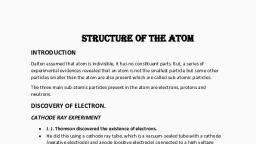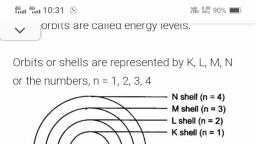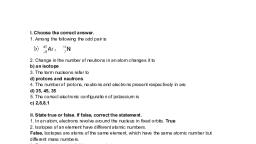Page 1 :
Bohr's Model of the Atom , In 1913, a Danish scientist Neils Bohr suggested an atomic model to explain structure of atom and to overcome Rutherford's limitations., Niels Bohr put forward a thought that electrons can be found only in certain energy levels, or regions, around the nucleus. Electrons must gain energy to move to a higher energy level or they must lose energy to move to a lower level., Restricting the path of electron inside the atom, Neils Bohr made the following postulates about the model of an atom:, The electrons revolves round the nucleus in certain, discrete circular orbits of the atom. These orbits or shells are called energy levels., While revolving in these discrete orbits the electrons do not radiate energy and this is the reason why electrons do not fall into the nucleus., The electron orbits or shells are represented by the letters K, L, M, N… or the numbers, n=1, 2, 3, 4, …..
Page 2 :
Limitations of Bohr model , Niels Bohr could successfully explain the properties of a hydrogen atom like the atomic spectra emitted by hydrogen atom employing this model but this model could not predict the spectra of atoms or ions with more than one electron. , Until Rutherford's and Bohr's time the neutron had not been discovered. Neutron was discovered nearly two decades later. , Except hydrogen atom, the atoms of all other elements contain neutrons in their nuclei., We studied that the mass of neutrons and proton is almost equal and is about 1836 times heavier than the mass of the electron. So the mass of the entire atom is due to protons and neutrons. , Later, it was discovered that most of the mass was concentrated inside the nucleus and therefore the neutrons are also present inside the nucleus., Give the main postulates of Bohr’s model of an atom.
Page 3 :
Explain the efforts made by scientists to explain the structure of atom by developing various atomic models?
Page 4 :
Distribution of electrons in different orbits (Shells) , According to atomic models, electrons move around the nucleus of atom in various shells. Electrons in different shells have different energies. , Each shell is represented by a number 'n' which is known as a shell number or energy level index. , The shell closest to the nucleus (and has the lowest energy) is called the K-shell (n = 1), the shell farther away (and has higher energy than K-shell) is called the L-shell (n = 2), etc., How many electrons can be accommodated in each shell of an atom?, Can a particular shell has just one electron?, What is the criteria to decide number of electrons in a shell? , After explaining the structure of atom with different atomic models, scientists started describing the distribution of electrons in different energy levels or shells of an atom.
Page 5 :
Rule 2: Each energy level or electron shell is further divided into sub shells. The maximum number of electrons that can be accommodated in each sub shell is 8. , Rule 3: Electrons cannot be filled in a given shell unless the inner shells are completely filled i.e., shells are filled in stepwise manner.
Page 6 :
Let us take the example of oxygen where Z=8. , Number of electrons is equal to number of protons, it has eight electrons., Step1: The K shell can accommodates maximum 2 electrons so the first 2 electrons fill the shell of n = 1. , Step 2 : The other 6 electrons will fill the higher shell n = 2 or the L shell. , Step 3: Then, the electronic structure for oxygen atom is 2, 6. , Arrangement of electrons for the first eighteen elements is shown in figure.




































































